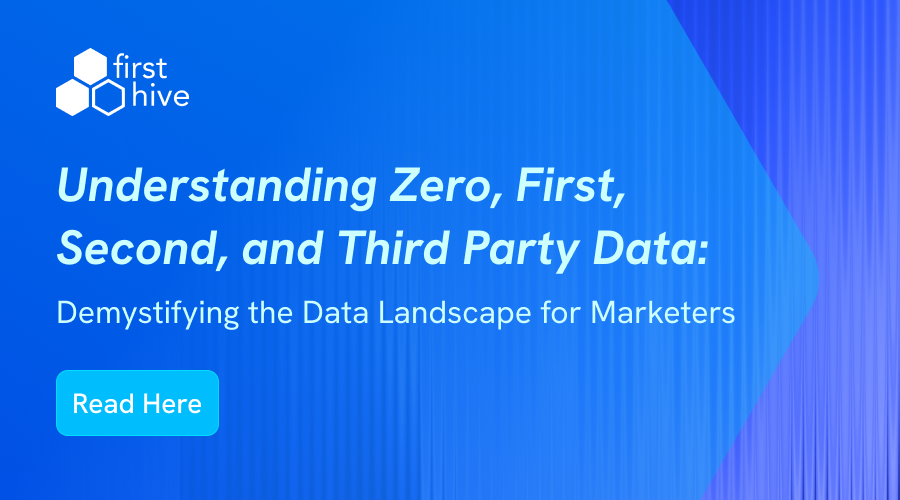Marketers are constantly seeking insights to better understand their customers and drive impactful strategies. However, navigating the complexities of data types can be daunting. In this blog, we’ll delve into the distinctions between zero, first, second, and third party data, their roles in understanding the customer journey, the technologies used to capture each data point, the pivotal role of Customer Data Platforms (CDPs), and how data trends are shaping the future of marketing.
Demystifying Zero, First, Second, and Third Party Data
Zero Party Data
Zero party data refers to information that consumers willingly and proactively share with brands. This includes preferences, feedback, and survey responses obtained directly from the customer. Zero party data is highly valuable as it provides explicit insights into customer intentions and preferences, enabling brands to personalize experiences effectively.
First Party Data
First party data comprises information collected directly by a brand from its own interactions with customers. This includes website analytics, purchase history, CRM data, and social media engagement. First party data is considered the most reliable and valuable as it offers direct insights into customer behavior and preferences.
Second Party Data
Second party data is essentially someone else’s first party data, acquired through a direct relationship or partnership. This data is obtained from trusted sources such as publishers, affiliates, or strategic partners. Second party data allows brands to access additional insights about their target audience from credible sources.
Third Party Data
Third party data is aggregated from various external sources and is typically purchased from data providers. This includes demographic information, behavioral data, and interests collected from various sources. While third party data offers scale and breadth, its quality and relevance can vary, making it less reliable than first party data.
Why Understanding Each Data Set Matters for Marketers
Personalized Marketing
Understanding zero, first, second, and third party data enables marketers to create highly personalized experiences tailored to individual preferences and behaviors. By leveraging insights from each data set, brands can deliver relevant content, offers, and recommendations that resonate with their audience.
Improved Targeting and Segmentation
Effective targeting and segmentation rely on a deep understanding of customer attributes and behaviors. By analyzing zero, first, second, and third party data, marketers can identify distinct customer segments, refine targeting criteria, and optimize marketing campaigns for maximum impact.
Enhanced Customer Engagement
By harnessing insights from all data sets, marketers can enhance customer engagement across the entire customer journey. From initial awareness to post-purchase interactions, personalized messaging and experiences foster stronger connections and drive customer loyalty.
Capturing and Activating Data: Technologies and Strategies
Technologies for Data Capture
Customer Relationship Management (CRM) Systems: Capture and manage first party customer data, including contact information, interactions, and transactions.
Web Analytics Platforms: Track website visitor behavior, traffic sources, and conversion metrics to gain insights into online interactions.
Data Management Platforms (DMPs): Aggregate and organize third party data from multiple sources for audience targeting and segmentation.
Also read our blog: DMP vs CDP vs CRM
Role of Customer Data Platforms (CDPs)
CDPs play a pivotal role in capturing, unifying, and activating data from all sources to create a unified customer view. By integrating zero, first, second, and third party data, CDPs enable marketers to gain actionable insights, segment audiences effectively, and deliver personalized experiences across channels.
The Changing Landscape of Data Trends and the Future of Marketing
Shift Towards Privacy and Consent
As data privacy regulations evolve, marketers are increasingly focused on obtaining explicit consent and prioritizing consumer privacy. This shift necessitates a greater emphasis on zero and first party data, obtained with consent directly from customers.
Rise of Predictive Analytics and AI
Advancements in predictive analytics and artificial intelligence empower marketers to leverage data more effectively for predictive modeling, personalized recommendations, and real-time decision making. These technologies enable brands to anticipate customer needs and deliver hyper-personalized experiences at scale.
Embrace of Data Collaboration and Partnerships
Collaborative data partnerships are emerging as a key trend, enabling brands to access valuable second party data from trusted partners. By sharing data responsibly and ethically, brands can enrich their understanding of the customer journey and drive mutually beneficial outcomes.
Navigating the Data Landscape with Confidence
In today’s data-driven marketing landscape, understanding the nuances of zero, first, second, and third party data is essential for success. By leveraging insights from each data set and harnessing the power of Customer Data Platforms, marketers can create personalized experiences, drive engagement, and build lasting relationships with their customers. As data trends continue to evolve, embracing innovation and staying ahead of the curve will be critical for brands looking to thrive in the future of marketing.
To Learn more about CDPs and their role in your effective data strategy, speak with us.








